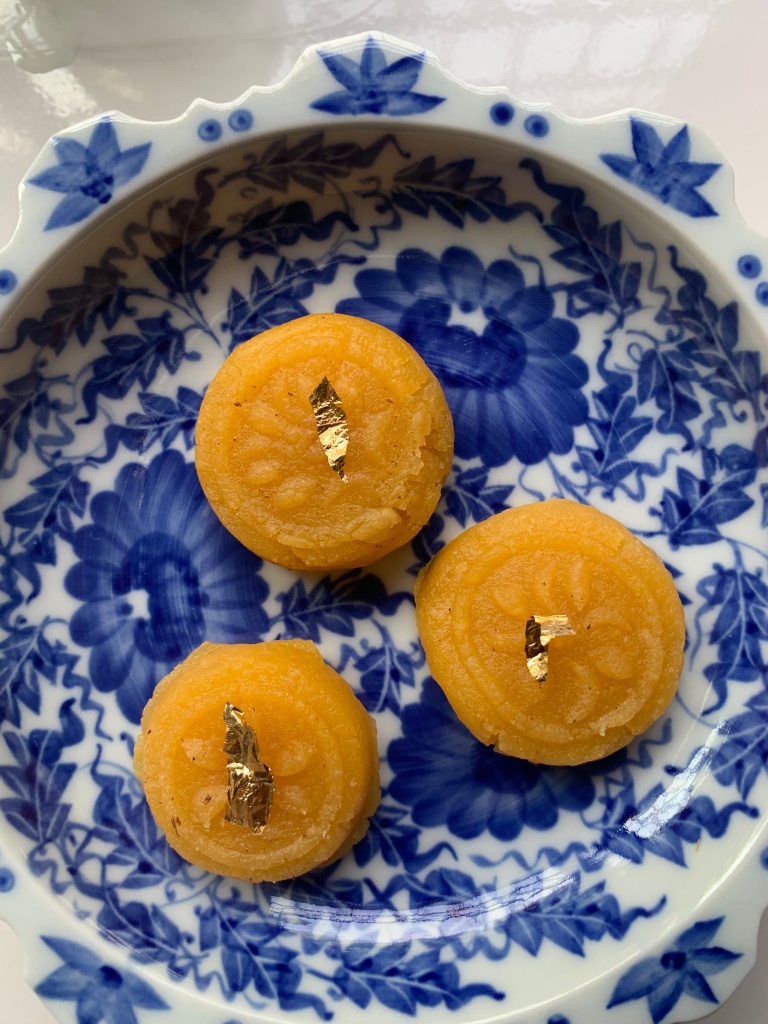
Happy New Year สวัสดีปีใหม่
In Thailand there are type of desserts made with egg yolks that are considered lucky or auspicious. This one, Kanom Thong Ek (ขนมทองเอก or ขนมทองเอกกระจัง ), variously translated as the prime gold candy, golden supreme, or the-one-and-only is one sweet of a class of Portuguese-inspired desserts made with the aforementioned egg yolks, and coconut milk, sugar, and flour. Because of their color and especially when they are topped with a bit of gold leaf, these sweets are enjoyed at New Year to symbolize wealth and good luck.
These treats are from a recipe by Leela Punyaratabhandu called No-Bake Almond Cookies, which are made with almond flour instead of wheat, and which I think gives the kanom (dessert, sweet, or cookie in English) a delicate nutty flavor as well as a moist tenderness not found in the wheat version. Traditionally, the cookies are scented with jasmine but I like adding almond or vanilla to them to bring out the nuttiness of the almond meal. These cookies are not baked but cooked on the stovetop until it becomes a shiny cohesive dough, and a white skin forms on the bottom of the pan. The cooked dough is scooped into a ball which is then stuffed into a wooden mold. The mold is tapped upside down on the countertop to release the cookies.
Kanom Thong Ek: Thai Golden Almond Cookies (adapted from Leela Punyaratabhandu)
Yield: 20-27 two-inch cookies
3/4-cup/240g unsweetened coconut milk
1 cup/200g superfine or caster sugar
6 large egg yolks
1 1/2-cups/144g blanched almond meal (aka powdered almonds or almond flour)
1/4 teaspoon/2g fine salt
1 teaspoon/4g almond or vanilla extract
1/4 cup/30g cornstarch for dusting the mold
Edible gold leaf, recommended but entirely optional
Special Equipment: 14-inch skillet, wooden mold for moon cakes, skewer or toothpick
In a heavy skillet, combine the coconut milk, sugar, egg yolks, almond meal, salt, and extract. Whisk until smooth. Turn the heat to medium high and cook, stirring constantly with a silicone spatula, until a soft, sticky dough forms, about 20 minutes. The dough is cooked when the surface is glossy and smooth, and a thin cloudy film forms on the bottom of the pan.
Scrape the dough into a bowl and cover with plastic wrap, pressing the plastic onto the surface of the dough to prevent a skin from forming as it cools. Chill or let cool to room temperature.
Line the work surface with a clean towel. Using a pastry brush, lightly dust the mold with cornstarch. Tap out the excess. Using a 1 1/2-inch scoop, scoop dough from the ball and roll it smooth between your hands. Press it into the mold. Press down into the mold to set the pattern. Lightly tap the mold upside down on the towel to release the cookies. Repeat the process until no dough remains. Top each cookie with a tiny shred of golf leaf. Use the toothpick or skewer to remove any cornstarch or dough stuck in the mold’s crevices, otherwise the pressed pattern won’t be very clear.
Store cookies in an airtight container at room temperature in a dry climate for up to 3 days. Otherwise, I recommend the cookies be refrigerated.
Note:
-if you haven’t got a wooden mold (see photograph below) you can press the cookie dough into a 6-inch square pan to a half-inch thickness, then cut into squares. Alternatively you can use a small round cookie cutter.
-wooden molds are available on Amazon, Walmart, or Asian specialty shops. Choose molds with cups that are shallower and smaller than the plunger-type mooncake molds or other wooden mooncake molds.

